RODIN Events and EXHIBITION OVERVIEW 2005
|
|
Check the date at the RODIN-WEB Calendar: MSIE
only.
See Exhibition overview for: 2001
2002 2003
2004 2006 |
|
from May 2005 :
except. presentation in showroom 6 (C. claudel)

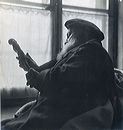

|
"Mes trésors antiques"
la
collection d'antiques d'Auguste Rodin.
Paris, musée Rodin
A partir de mai 2005, la salle Camille Claudel, vidée de son contenu
en raison d’une exposition extérieure (Québec, Detroit et Martigny),
accueillera quelques antiques de l'immense collection de plus de 6400
oeuvres, rassemblée par Rodin entre 1893 et 1917. Cette présentation
provisoire, avant la fermeture pour travaux de l’hôtel Biron,
préfigure le nouveau parcours du musée. Cette salle permettra au
visiteur de remonter dans le temps, à l’époque où l'artiste hantait
les lieux et où sa collection était exposée parmi ses propres
sculptures et dessins.
Cette nouvelle salle ne sera pas une reconstitution d'un état antérieur
au sens strict du terme mais tentera d’évoquer, tant par le choix et l’association
des œuvres que par les modes de présentation et la profusion, ce que fut
le musée personnel du sculpteur. « Non moins qu’un grand artiste, c’est
un passionné collectionneur. Son enthousiasme pour l’antiquité est un
monstre dévorant auquel il jette sans compter les ressources que lui
procure son art » rapportait le critique Paul Gsell en 1907 lorsque Rodin
le conviait à contempler sa collection, présentée alors à la villa des
Brillants, à Meudon: « Il faut que je vous montre mes trésors antiques.
Venez me voir : nous les regarderons ensemble. »
C’est l’invitation que lance aujourd'hui le musée Rodin, avec l’ambition
de montrer ces antiques comme des créations propres du sculpteur.
|
|
6 Jun. - 1O Sept. 2005
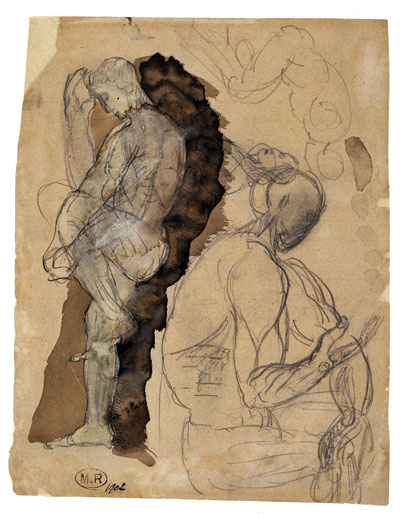
|
"Hommes"
Rodin
et les dessins de nus masculins.
Paris, musée Rodin
Au premier abord, la femme semble être le sujet favori de Rodin. Ses
dessins de nus féminins sont en effet parmi les plus connus de son œuvre
graphique. Pourtant, jusqu’à l’âge de 50 ans, c’est principalement
au corps de l’homme que Rodin s’est intéressé. Dès ses années d’apprentissage,
c’est le nu masculin qui prédomine dans ses soigneuses copies d’antiques
et ses académies. En 1877, Rodin étudie assidûment l’œuvre de
Michel-Ange dont l’influence se répercute sur ses dessins inspirés de
Dante pour la Porte de l’Enfer. Ces dessins représentent surtout des
écorchés et des hommes à la musculature soulignée. Quant aux femmes,
elles aussi sont comme imprégnées de virilité. Sorti de la Porte de l’Enfer,
dans les années 1890, Rodin s’intéresse moins au corps masculin, même
si, des années 1900, il nous reste de sa main une centaine de dessins
très libres, rapidement crayonnés, parfois retravaillés à l’aquarelle
et à la gouache, véritables chefs d’œuvres. En somme, une exposition
qui propose un parcours inédit de l’œuvre graphique de Rodin.
|
|
27
Sept. 2005 - 29 Jan. 2006
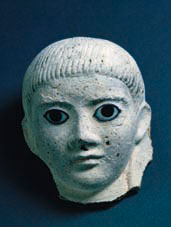
|
"Masques et tissus d’Egypte"
la
collection d'antiques d'Auguste Rodin.
Paris, musée Rodin
En contrepoint de la nouvelle salle des antiques, le musée Rodin
expose pour la première fois, dans la pénombre du cabinet des arts
graphiques, des masques funéraires en plâtre gréco-romains et des
tissus coptes de la collection du sculpteur.
Ces œuvres apparaissent en Europe à la fin du XIXème siècle, à peine
sorties des chantiers de fouilles égyptiens. Le grand public découvre
les tissus coptes lors de l’Exposition Universelle de 1900 : l’engouement
est immédiat. Dès les années 1902-1903, Rodin achète sur le marché de
l’art parisien les premiers masques et tissus qu’il expose, parmi ses
œuvres et sa collection d’antiques, à la Villa des Brillants à
Meudon. À sa mort en 1917, il ne possède pas moins de vingt masques et
une centaine de fragments d’étoffes. Des photographies et des archives
de l’époque témoignent de l’histoire de ces œuvres du vivant de l’artiste.
Here
you can download the press release (29 kb) 
|
|
17 nov. 2005 –26 feb. 2006
 
 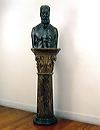
|
"Rodin, Brancusi, Giacometti,
Louis Bourgeois, Vermeiren…"
La
sculpture dans l’espace.
Paris, musée Rodin
A quelle hauteur doit être placée une sculpture ? Voilà l’une des
questions soulevées par la présentation magistrale à 4 mètres en l’air
des Bourgeois de Calais dans l’espace rénové de la Chapelle du musée
Rodin. Plus d’une centaine d’œuvres de Rodin principalement mais
également de Brancusi, Giacometti, Louise Bourgeois jusqu’à Didier
Vermeiren et Richard Wentworth se penchent sur la question du support de l’œuvre.
Intermédiaire entre le sol et l’œuvre, contribuant à lui donner du
sens, devenant partie intégrante de l’œuvre, le socle finira par
prendre la place de la sculpture comme chez Vermeiren ou Wentworth.
Commissaire de l’exposition: Antoinette Le Normand-Romain
Exposition présentée dans le nouvel espace d’exposition
temporaire du musée Rodin avec le soutien de Mainichi Shinbun
Here you
can download the press release (32 kb) 
|
|
Musée national des
beaux-arts du Québec
26 May - 11 Sept. 2005
Detroit Institute of Arts
Detroit, Michigan
9 Oct. 2005 - 5 Feb. 2006
Fondation Pierre Gianadda
Martigny, Suisse
3 March - 11 June 2006
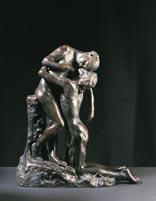
|
"Camille claudel & rodin:
fateful encounter"
For a brief, happy period, the two artists had an intense love affair
fired by a common passion for sculpture. Claudel was present and involved
during the creation of Rodin’s masterpieces in the 1880s and early
1890s. In the progression of her training in Rodin’s studio, she soon
sculpted works of remarkable character and expressive power.
Then came the storm. While Rodin’s new vision of sculpture spread over
France and the world, Claudel struggled to have her work recognized in its
own right. Irreconcilable artistic and personal differences developed.
Their love dwindled. As Rodin’s skill and reputation grew, he was
recognized as an artistic genius. He was often compared with the Italian
master Michelangelo, as each was the most famous artist of his time.
Meanwhile, Claudel withdrew and struggled with psychological problems,
which caused her to be institutionalized for the last three decades of her
life.
This exhibition is the first in the United States to shed light on these
sculptors’ mutual influences. Photographs and letters provide an entry
into their private lives. Above all, more than 120 works tell the story of
two talented and committed artists determined to find their way, without
compromise.
Exhibition organized by Musée national des beaux-arts du
Québec, in Québec City, with Musée Rodin in Paris.
|
|
Kunsthalle
Emden
Ostfriesland, Germany
22 Oct. 2005 - 15 Jan. 2006
Kunst-
und Skulpturenmuseum Heilbronn,
Germany
9 July - 9 Oct. 2005
Museum
Liner
Appenzell, Switzerland
29 Jan. - 16 April 2006
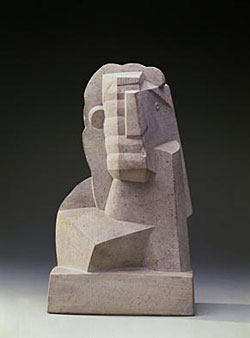
|
"Die obere hälfte –
Die Büste seit Auguste Rodin"
Erstmals wird das traditionelle Bildhauerthema, das im 20. Jahrhundert
eine entscheidende Wendung erfährt, in einer großen Schau beleuchtet.
Die Ausstellung hat das Ziel, die enorme Vielfältigkeit, welche die auf
die Antike zurückgehende Gattung der Büste seit Ende des 19.
Jahrhunderts erlebte, einem breiten Publikum nahe zu bringen. Anhand von
rund 100 Werken wird das Thema in all seinen stilistischen Ausprägungen
beleuchtet. Die Ausstellung zeigt dabei eine Entwicklung, in der sich die
Büste zunehmend von gängigen Vorstellungen befreit und sich
traditionellen Formen der klassischen Büste verweigert.
Zwei Bildhauern kommt in diesem spannenden Prozess geradezu revolutionäre
Bedeutung zu: Auguste Rodin sowie Alberto Giacometti. Gezeigt werden
außerdem Werke u.a. von Honoré Daumier, Medardo Rosso, Constantin
Meunier, Emile-Antoine Bourdelle, Henri Laurens, Wilhelm Lehmbruck, André
Derain, Henry Moore, Dieter Roth, Daniel Spoerri, Timm Ulrichs, Mimmo
Paladino, A.R. Penck, Markus Lüpertz, Wim Delvoye, Ah Xian, Marc Quinn,
Rosemarie Trockel, Stephan Balkenhol, Magdalena Abakanowicz, Leiko
Ikemura, Wang Du und Katsura Funakoshi.
Das Ausstellungsprojekt ist eine Kooperation der Städtischen Museen
Heilbronn mit der Kunsthalle in Emden und dem Museum Liner Appenzell
(Schweiz). Die Ausstellungsreihe wird in den Städtischen Museen Heilbronn
beginnen und anschließend in Emden und Appenzell zu sehen sein.
Es erscheint ein Katalog: 192 Seiten, 143 Farb- und 37 s/w-
Abbildungen. Mit Beiträgen von Dieter Brunner, Achim Sommer, Toni Stooss
u. a. Preis an der Museumskasse: € 24,80.
|
|
4 Sept. – 20 Nov. 2005
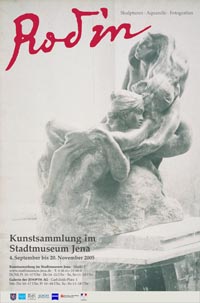
|
"RODIN - Skulpturen, Aquarelle, Fotografien"
Stadtmuseum Jena, Germany
Der künstlerische Ansatz von Rodins Arbeiten wurzelt im 19.
Jahrhundert, doch überwand er den gefälligen Idealismus seiner
Vorgänger und gab seinen Skulpturen spannungsreiche, zwischen Licht und
Schatten gelagerte Oberflächen, die an impressionistische Malerei
erinnern. Insgesamt lässt sich Rodins gigantisches Werk jedoch nicht auf
einen Stilbegriff festlegen, vielmehr schuf er eine kraftvolle,
eigenständige Formenwelt, die von der Erfahrung des Menschlichen mit all
seinen seelischen und geistigen Regungen, Leidenschaften und Konflikten
tief durchdrungen ist. Er suchte nach der Wirklichkeit dieser Welt und
fand in der Bewegtheit seiner Werke eine formale Entsprechung. Rodin sieht
Wesentliches und Unwesentliches, er folgt den Menschen durch Kontraste und
Übergänge, sieht Verbindungen, durchblickt Maskeraden und bündelt all
diese großen und kleinen Lebensmomente in seinen Werken. Als erster
moderner Bildhauer erhob Rodin das Unvollendete zum künstlerischen
Prinzip.
Das 100jährige Jubiläum der Verleihung der Ehrendoktorwürde ist Anlass
dieser mit mehr als 150 Werken umfangreichen Ausstellung. Neben den
Originalen aus Gips werden Bronze- und Marmorskulpturen, darunter viele
Hauptwerke, gezeigt. Die Auswahl der Skulpturen wird durch 70 Aquarelle
und eine kleine Kollektion originaler Fotografien von Eugène Druet, dem
legendären Fotografen Rodins, und einige historische Dokumente
ergänzt.
|
|
3
Sept. - 20 Nov. 2005
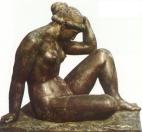
|
"Aristide Maillol -
Bildhauer, Maler, Zeichner, Graphiker"
Kunsthaus Apolda, Germany
Die Schau in Apolda umfasst etwa 90 Arbeiten von Maillol, der ebenfalls
als einer der großen Bildhauer des 20. Jahrhunderts gilt. Hauptthema
seines bildhauerischen Schaffens war der weibliche Akt. Unter dem Titel
«Der Zauber einfacher Formen» will die Ausstellung an das vor 100 Jahren
im Auftrag des Weimarer Kunstförderers Harry Graf Kessler entstandene
Werk «La Méditerranée» (1902/1905) erinnern. Mit dieser Arbeit
begründete der damals 43 Jahre alte Maillol seinen Ruf als Erneuerer der
europäischen Plastik in der ersten Hälfte des 20. Jahrhunderts.
Für die Retrospektive in Apolda stellten die Fondation Dina Vierny und
das Musée Maillol in Paris Leihgaben zur Verfügung.
|
|
9 Sept. - 27 Nov. 2005


|
"Rodin Beuys"
Kunsthalle Schirn, Frankfurt, Germany
The juxtaposition of drawings and sculptures by Joseph Beuys and
Auguste Rodin may at first seem surprising. In fact, however, Beuys
created hundreds of works on paper between 1947 and 1964 which reveal
formal reminiscences of Auguste Rodin’s late drawings and watercolors.
Although Rodin, unlike Beuys, was fascinated by the female body as an
object of desire, both considered women to be the epitome of elemental
transformative natural forces. Like Rodin, and Wilhelm Lehmbruck after
him, Beuys’s three-dimensional works take up the idea of the torso as an
autonomous form and of the fragment as the embodiment of the enduring.
With more than one hundred works on paper and fifty masterpieces of
sculpture, the presentation will shed light both on the relationship
between Rodin and Beuys and on Beuys’s intense engagement with the work
of Lehmbruck.
Curator: Pamela Kort, Berlin
|
|
25 Sept. 2005 - 29 Jan. 2006
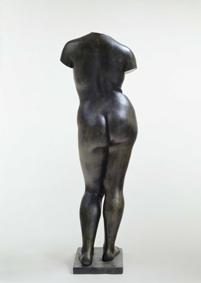
|
"Lehmbruck, Rodin, Maillol"
Wilhelm Lehmbruck Museum, Duisbourg,
Germany
Selected works by Wilhelm Lehmbruck are showcased together with
corresponding works and groups of work by the two artists who supported
and accompanied Wilhelm Lehmbruck’s art: Auguste Rodin (1840 - 1917) and
Aristide Maillol (1861 - 1944). In the dialogue between the three, which
climaxed during Lehmbruck’s stay in Paris (1910 - 1914), there emerges,
with regard to the figurative image of man, a highly varied approach to
the body and the torso. as well as volume and space. Lehmbruck searched
for a synthesis between the two poles of meaningful gesture on the one
hand (Rodin), and harmonizing, antique calm on the other (Maillol), before
finally deciding on sculpture as architecture and on the balance between
masses. It is with precisely these features that his initial admiration
for Rodin merges into the form of statues and eternal nature of Maillol.
In addressing this theme Lehmbruck discovered his own very individual
response to the entirely different works by the two “fathers of modern
sculpture” so as to compose war-scarred introverted personifications of
mourning and thinking, suffering and dying. The juxtaposition of Rodin’s
“Thinker” with Maillol’s “Night” and Lehmbruck’s “Fallen Man”
is just as much a highlight of the exhibition as all three artists’
treatment of the female torso in their major works.
In several themed rooms the exhibition places selected works by Wilhelm
Lehmbruck from the museum’s own collection alongside 30 sculptural works
by Rodin and Maillol. Those objects on loan come from some of the best
collections of these artists’ work, namely the Musée Rodin and the
Musée Maillol in Paris, as well as Antwerp (“La Méditeranée”),
Dortmund (“Pomona”) and Winterthur (“La Nuit”, “Flora”).
In conjunction with the exhibition a richly illustrated
catalogue will be available. It contains essays and explanations for all
58 exhibited works as well as numerous pictures. Published by C. Brockhaus
at Wienand Verlag, Cologne, 176 pages, 19,80 €.
|
|
6 Oct. 2005 - 15 Jan. 2006
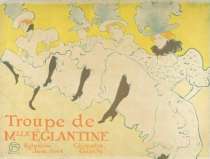
|
"Degas, Sickert and Toulouse-Lautrec: London and Paris 1870–1910"
Tate Britain, London
Degas, Sickert and Toulouse-Lautrec presents the height of decadence
this autumn, featuring many of the most famous images of ballet dancers,
can-can girls and music hall singers from the turn of the century. The
exhibition explores the frenzied exchange of ideas between British and
French painters of the time and presents a debauched modern world of
decadence, entertainment and dandyism.
Among the many great images is Edgar Degas’s L’Absinthe 1875–6, lent
by the Musée d’Orsay and not seen in an exhibition in London since the
nineteenth century. It was condemned as 'immoral', 'vulgar', 'boozy' and
'degraded' when it was shown in London in 1893, whereas others instantly
proclaimed it a masterpiece, demonstrating the divided feelings over the
new art techniques and subject matter.
While Edgar Degas, Walter Sickert and Henri de Toulouse-Lautrec dominate
the exhibition, the show presents modern scenes by many other innovative
painters, such as Pierre Bonnard, Edouard Vuillard, James Abbott McNeill
Whistler and James Tissot. Drawing on a range of international collections
in Europe, Australia and the United States, this is an unmissable chance
to explore a moment of brilliant artistic invention and see some of the
most beautiful paintings from the founding years of modern art.
|
| |
|
















